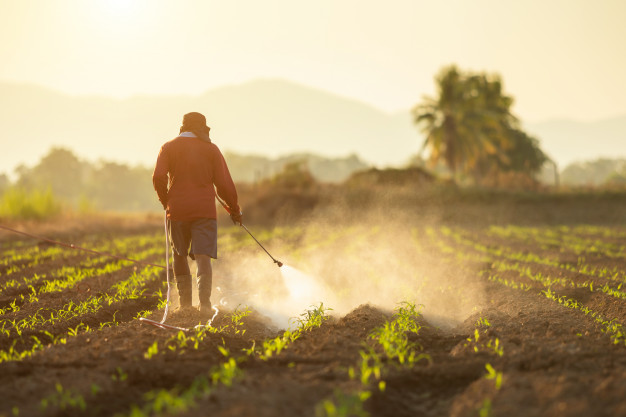Humans have utilised pesticides since 2000BC to protect their crops.
The first pesticide was elementary sulphur dusting. Also
poisonous plants were used as pesticides.
What are pesticides?
Pesticide= pest (insect or animal that destroy plants, food etc) + cide (to kill)
So pesticide is a substance or mixture of substances used for preventing, destroying and controlling any pests and disease carriers. This also prevents some species of plants and animals that causes harm or interferes in the growth of plants/ crops.
We can also say pesticides are biological or chemical agents that are used to deter, incapacitate, kill or discourage pest increase. They are classified on the basis of biological mechanisms function or application method.
Pesticide is also used in protecting crops from insects, plant pathogens, weeds and pests during production, processing, storage, transport, marketing of food, agricultural commodities, wood and wood products or animal feedstuffs.
Weeds compete with crops for light and nutrients.
It is estimated that the worlds crops yield is reduced by 10-15% due to presence of weeds. So it is necessary to use herbicides and pesticides for better crop yield.
Pesticide can be considered as :
1.
Biodegradable – This can be broken down by microbes and other living beings into harmless compounds that dissolve in soil.
2.
Persistent – These pesticides take months and years to break down.
Types of pesticides
Biopesticides
These are
naturally occurring or derived materials from living organisms or their metabolism. They come from animals, plants, minerals, bacteria. Only target pest and closely related organism are affected by these pesticides. They decompose quickly and pollution problems are avoided. They are less toxic to humans and the environment.
Some biopesticides are bactericides, fungicides, herbicides, rodenticides, insecticides, larvicides, molluscicides, ovicides etc.
Bio pesticides are categorised as:
a.
Microbial pesticides:
These include micro-organisms (bacteria, fungus, virus, protozoa) as active ingredients. Its advantage is that most microbial pesticides replicate in their target host and remain in the environment . This causes long term supression of pest population without repeating the application.<br.
For example some fungi can kill certain weeds and other kind of fungi to kill certain insects.
Bacillus thuringiensis(Bt) produces a protein that binds to gut of larvae to make it starve.
b.
Biochemical pesticides:
These pesticides are naturally occurring substances that control pests by non-toxic mechanism. These pesticides interferes in the mating process of insects to reduce their number. Also scented plant extracts are used to trap insect pests.
c.
Plant-incorporated pesticides:
These are substances produced by plants from genetic material added to the plant. Here the insect destroying property of the microbes are genetically added to the plant.
For example Bacillus thuringiensis( Bt) pesticides protein gene is introduced into plants genetic material so that it can manufacture the substance that destroys the pest as Bt does.
Chemical pesticides
Chemical reagents used to protect crops from various pests. Industrialization of agricultural sector increase the use of chemical on natural ecosystem. This is causing negative effect on environment and human health.
Organophosphate
-
– It is a chemical substance produced by
esterification
-
process between phosperic acid and alcohol. This is a variety of insecticide that is highly toxic to insects.
b.
Carbamate – It is a chemical compound derived from carbamic acid. It kills insects as organophosphate does. This is used in gardens, agriculture,etc.
Pyrethroids
-
– It is an organic compound similar to natural pyrethrin, produced by
Chrysanthemum flower
-
. It is used as commercial household insecticide. It has insect repellent properties and harmless to humans. It can be toxic for some beneficial insects (bees, mayflies, dragonflies) and invertebrates.
d.
Sulphonylureas – This is a substitute urea herbicide(SUH).These are herbicides that inhibit plant enzyme (acetolactate synthace) resulting into potential herbicides. It is used to control weeds and unwanted grass.
Uses of various pesticides
-
1. Pesticides are applied and coated to seeds prior to planting to protect it from soil-borne diseases by soil treatment process. Seed coating is done with nutrients like nitrogen, phosphorus, pottasium and other micro-organisms making it less vulnerable to diseases.
-
2. Slowing the growth of algae by using algaecides.
-
3. Fungicides are used to control fungal problems like molds, mildew and rust.
-
4. Herbicides are used to kill or inhibit the growth of unwanted plants.
-
5. Rodenticides are used to kill mice, rodents, gophers.
-
6. Wood preservative are used to protect wood from insects, fungus, pests.
-
7. Use of pesticides in forestry, public health, domestic sphere has increased the productivity of agricultural products.
-
8. Vector borne diseases are controlled by killing the vectors. Insecticides are used to control insects that spread deadly diseases like malaria. Disease control strategies are also crucial for protecting livestock.
-
9. Herbicides and pesticides are used to maintain sports pitches, Cricket grounds, golf courses.
-
10. Avicides are used to protect crops from birds.
-
11. Molluscicides are used to protect plants from snails.
-
12. Antifouling agents are used to kill organisms that attach to underwater surfaces like boat bottoms.
-
13. Fumigants are gases and vapours that are intended to destroy pests on buildings and soil.
-
14. Pheromones are used to disrupt the mating behaviour of insects.
-
15. Ovicides are used to destroy the eggs of various insects, mites and other plants destroying organisms.
Conclusion
In a summary, we can say pesticides are fulfilling their intended purpose of controlling pests population. Chemical pesticides should be higly avoided. We should try to explore new varieties of biopesticides that would be promising to increase benefits and reduce the risks of environmental pollution. If you are looking for organic pesticides, enzymes and micronutrients and
so on, try
Nivshakti Bioenergy Pvt. Ltd. the best organic fertilizer manufacturers in India. We have been in the market since 2003 and our main focus is to provide maximum customer satisfaction.
